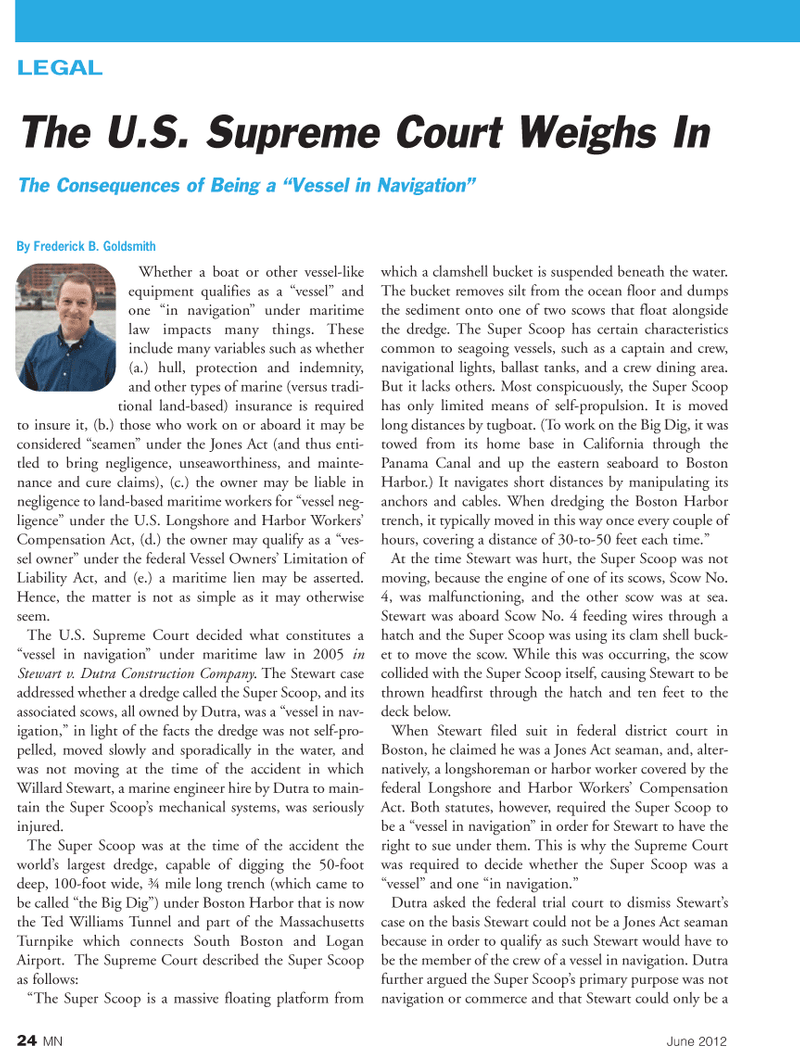
Page 24: of Marine News Magazine (June 2012)
Dredging & Marine Construction
Read this page in Pdf, Flash or Html5 edition of June 2012 Marine News Magazine
24MNJune 2012 Whether a boat or other vessel-like equipment qualifies as a vessel? and one in navigation? under maritime law impacts many things. These include many variables such as whether (a.) hull, protection and indemnity, and other types of marine (versus tradi- tional land-based) insurance is required to insure it, (b.) those who work on or aboard it may be considered seamen? under the Jones Act (and thus enti- tled to bring negligence, unseaworthiness, and mainte- nance and cure claims), (c.) the owner may be liable in negligence to land-based maritime workers for vessel neg- ligence? under the U.S. Longshore and Harbor Workers Compensation Act, (d.) the owner may qualify as a ves- sel owner? under the federal Vessel Owners Limitation of Liability Act, and (e.) a maritime lien may be asserted. Hence, the matter is not as simple as it may otherwise seem.The U.S. Supreme Court decided what constitutes a vessel in navigation? under maritime law in 2005 inStewart v. Dutra Construction Company . The Stewart case addressed whether a dredge called the Super Scoop, and its associated scows, all owned by Dutra, was a vessel in nav- igation,? in light of the facts the dredge was not self-pro- pelled, moved slowly and sporadically in the water, and was not moving at the time of the accident in which Willard Stewart, a marine engineer hire by Dutra to main- tain the Super Scoops mechanical systems, was seriously injured. The Super Scoop was at the time of the accident the worlds largest dredge, capable of digging the 50-foot deep, 100-foot wide, ¾ mile long trench (which came to be called the Big Dig?) under Boston Harbor that is now the Ted Williams Tunnel and part of the Massachusetts Turnpike which connects South Boston and Logan Airport. The Supreme Court described the Super Scoop as follows: The Super Scoop is a massive floating platform from which a clamshell bucket is suspended beneath the water. The bucket removes silt from the ocean floor and dumps the sediment onto one of two scows that float alongside the dredge. The Super Scoop has certain characteristics common to seagoing vessels, such as a captain and crew, navigational lights, ballast tanks, and a crew dining area. But it lacks others. Most conspicuously, the Super Scoop has only limited means of self-propulsion. It is moved long distances by tugboat. (To work on the Big Dig, it was towed from its home base in California through the Panama Canal and up the eastern seaboard to Boston Harbor.) It navigates short distances by manipulating its anchors and cables. When dredging the Boston Harbor trench, it typically moved in this way once every couple of hours, covering a distance of 30-to-50 feet each time.? At the time Stewart was hurt, the Super Scoop was not moving, because the engine of one of its scows, Scow No. 4, was malfunctioning, and the other scow was at sea. Stewart was aboard Scow No. 4 feeding wires through a hatch and the Super Scoop was using its clam shell buck- et to move the scow. While this was occurring, the scow collided with the Super Scoop itself, causing Stewart to be thrown headfirst through the hatch and ten feet to the deck below. When Stewart filed suit in federal district court in Boston, he claimed he was a Jones Act seaman, and, alter- natively, a longshoreman or harbor worker covered by the federal Longshore and Harbor Workers Compensation Act. Both statutes, however, required the Super Scoop to be a vessel in navigation? in order for Stewart to have the right to sue under them. This is why the Supreme Court was required to decide whether the Super Scoop was a vessel? and one in navigation.? Dutra asked the federal trial court to dismiss Stewarts case on the basis Stewart could not be a Jones Act seaman because in order to qualify as such Stewart would have to be the member of the crew of a vessel in navigation. Dutra further argued the Super Scoops primary purpose was not navigation or commerce and that Stewart could only be a LEGALBy Frederick B. Goldsmith The U.S. Supreme Court Weighs InThe Consequences of Being a Vessel in Navigation?

 23
23

 25
25
